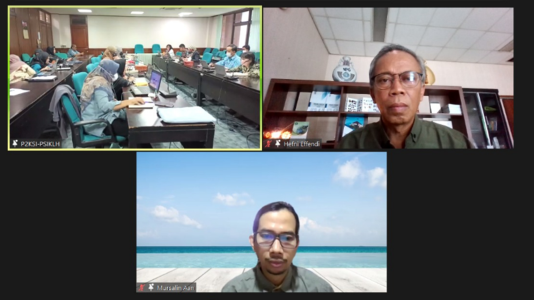Prof Hefni Effendi Presents the Concept of Hydropower Impact on Aquatic Environment

In a discussion held by the Center for Standardization of Environmental Quality Instruments (PSIKLH), Prof Hefni Effendi, Head of the Department of Aquatic Resource Management (MSP), Faculty of Fisheries and Marine Science (FPIK) IPB University gave a presentation related to the concept of the impact of Hydropower Plants (PLTA) on the aquatic environment. At that moment, he proposed the importance of studying aquatic biodiversity.
“The importance of this study is considering that the construction of the dam will change the flowing river ecosystem (lotic) into a relatively flooded ecosystem (lentic). Thus, there will be a modification of the aquatic biota community structure. Aquatic biota whose habitat preferences are inundated waters (lacustrine) can certainly thrive,” said Prof Hefni during his presentation in Serpong, Banten, some time ago.
He continued, the existence of migratory fishes, both anadromous (marine fishes that migrate to freshwater habitats to spawn) and catadromous (freshwater fishes that migrate to the sea to spawn) needs to be well studied.
“For our country, there are eels that spawn in the deep sea such as in the Indian Ocean, Banda Sea and others. The spawned eel larvae, called glass eel, will travel upstream to the river to spend their adult periods there.
“It can be imagined that if the river, which is a migration route for eels, is dammed for hydropower purposes, then undoubtedly the eels will gradually disrupt their reproductive cycle. It is possible that it will experience extinction,” he added.
According to Prof Hefni, one of the management efforts introduced in overcoming the obstruction of eel migration is by making fishways between dams.
The application of fishway in the form of fish ladder has long been applied in a number of dams in 4th climate countries such as Western Europe and North America. In these regions, there are salmon populations that migrate upstream to spawn (lay eggs) and mature in the sea, the opposite of the reproductive cycle of eels.
“Therefore, the eel fishery remains sustainable. Because the people there will not disturb the migrating eels, even though they are easily caught, especially when the eels pass through shallow rivers,” he said.
Prof Hefni emphasized, as a department that is adaptive to the problems of aquatic ecosystems and in order to increase global reputation, the MSP Department of IPB University has collaborated with Charles Sturt University, Australia in conducting fishway studies in a number of Indonesian regions.
In this discussion, not only the impact on the aquatic environment was elaborated, but also the influence on the surrounding environment of dam-based hydropower development and operation. The surrounding environment includes terrestrial and aquatic environments within the scope of a broad spectrum such as physical, chemical, biological, socio-economic-cultural aspects as well as public health and the environment.
Mursalin, MSi who is a research staff at SUA Proling Laboratory, Department of MSP IPB University also discussed the concept of the impact of port development and operations on the environment.
The conceptualization of the impact of hydropower is part of the efforts of the Ministry of Environment and Forestry (KLHK) to develop specific standards of environmental impacts of several project activities that are often carried out in Indonesia. (HEF/Rz) (IAAS/RUM)



